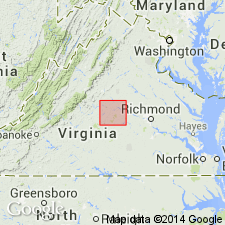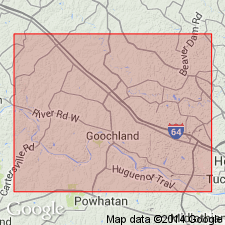
- Usage in publication:
-
- Elk Hill complex
- Modifications:
-
- Named
- Dominant lithology:
-
- Granite
- Schist
- AAPG geologic province:
-
- Piedmont-Blue Ridge province
Summary:
Named for Elk Hill, Goochland Co., southeastern VA. Complex is 1 to 1.5 mi wide where it crosses James River at Elk Hill. Best exposures are in bluffs 0.75 mi below Elk Hill. Consists of biotite granite, hornblende schist, and pegmatite which occur interleaved in layers of varying thickness and in places are contorted. Hornblendic rocks appears to have formed first and the granite intruded into it later, while pegmatite frequently cuts both granite and schist. Age is Precambrian and Cambrian. Report includes geologic map.
Source: GNU records (USGS DDS-6; Reston GNULEX).

- Usage in publication:
-
- Elk Hill complex
- Modifications:
-
- Age modified
- Overview
- AAPG geologic province:
-
- Piedmont-Blue Ridge province
Summary:
Age stated as Precambrian. Biotite granite in Elk Hill complex is probably equivalent to Columbia granite. Elk Hill rocks and rocks of pegmatite belt are equivalent to muscovite granite injected into Wissahickon formation, and have been included in granitized Wissahickon by some geologists.
Source: GNU records (USGS DDS-6; Reston GNULEX).
For more information, please contact Nancy Stamm, Geologic Names Committee Secretary.
Asterisk (*) indicates published by U.S. Geological Survey authors.
"No current usage" (†) implies that a name has been abandoned or has fallen into disuse. Former usage and, if known, replacement name given in parentheses ( ).
Slash (/) indicates name conflicts with nomenclatural guidelines (CSN, 1933; ACSN, 1961, 1970; NACSN, 1983, 2005, 2021). May be explained within brackets ([ ]).

